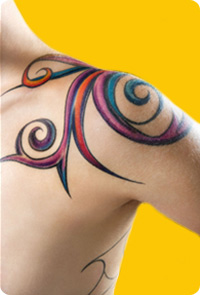Tattoo Procedure

The body art of tattooing mainly involves the procedure of injecting one or more pigments into the dermis, the layer of connective tissue that lies just below the epidermis. After the pigment is injected into the skin, the immune system's phagocytes get activated in the epidermis and upper dermis, swallowing up the pigment particles. The result is that the pigment goes down, throughout a homogenized damaged layer. As the particular body part undergoes healing process, the damaged epidermis starts flaking away.
With the flaking of epidermis, the pigment on the surface of the skin starts fading away. However, the deeper layers of skin experience the formation of granulation tissue. In time, owing to collagen growth, they get converted into connective tissues, mending the upper dermis. Since the upper dermis has pigment trapped within fibroblasts, its healing leads to the pigment in the layer just below the dermis/epidermis boundary. Soon, the pigment becomes stable and with the passing time, engrains pigment deeper into the dermis, forming the tattoo.
Traditional Procedures
In the earlier times, all the societies and cultures made use of different procedures for tattooing purposes. Some of these traditional procedures continue till date. For instance, in some tribal societies, tattoos are created by cutting designs into the skin and putting ink, ashes or other coloring agents into the wounds. In other cultures, tattoo making involves beating ink into the skin, using sharpened sticks or animal bones. Another tattooing method, mainly used in Japan, is called tebori. In this method, tattooing involves hand poking i.e. inserting the ink under the skin, with the help of non-electrical tools, which are handmade and handheld and have needles made of honed bamboo or steel.
The Modern Method
Today, the most common method of tattooing comprises of the use of electric tattooing machines. Apart from making the tattooing procedure much simpler, the machines have also increased its ease. The machine comprises of a group of needles that are soldered onto a bar. The bar has an oscillating unit attached to it. In the modern method, the ink is inserted into the skin, through the needles, which are repeatedly driven and out of the skin, somewhere between 80 and 150 times in a second.
The modern method of tattooing is much more hygienic as well as sterile as compared to the traditional methods. The needles used for the purpose are disposable in nature and come in individual packages. In the present times, almost all the tattoo artists take care to wash their hands as well as the 'area to be tattooed'. At the same time, they wear gloves and wipe the wound frequently, to prevent any infection or allergy. Still, one cannot completely do away with the risks involved with tattooing. | |
Other Categories
Tattoo Designs
Purposes of Tattooing
History of Tattoo
Tattoo Risks
Tattoo Meaning
Tattoo Types
Tattooing Tips
Tattoo Procedure
Tattoo Supply
Tattooing Cost
Tattooing Techniques
Tattoo Machine
Tattoo Ink
Tattoo Ideas
Tattoo Aftercare
Tattoo Removal
Tattooing And Body Piercing
Tattoo Books
Temporary Tattoos
Celebrity Tattoos
Criminal Tattoos
|

